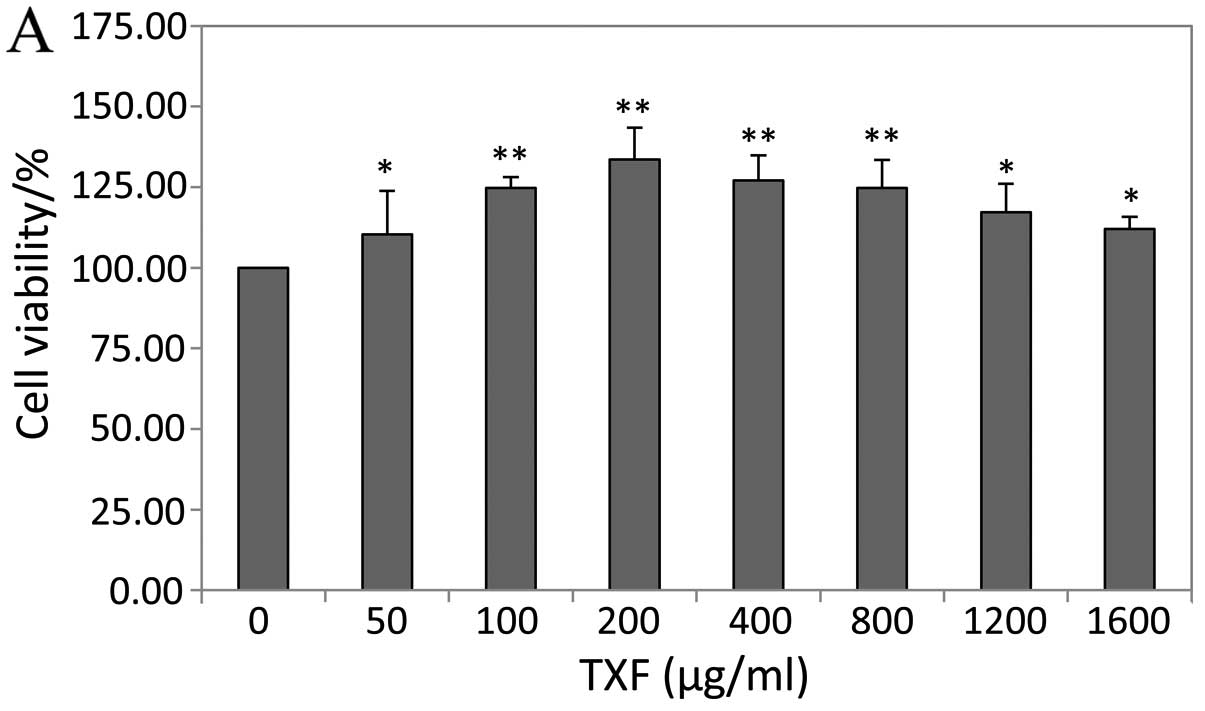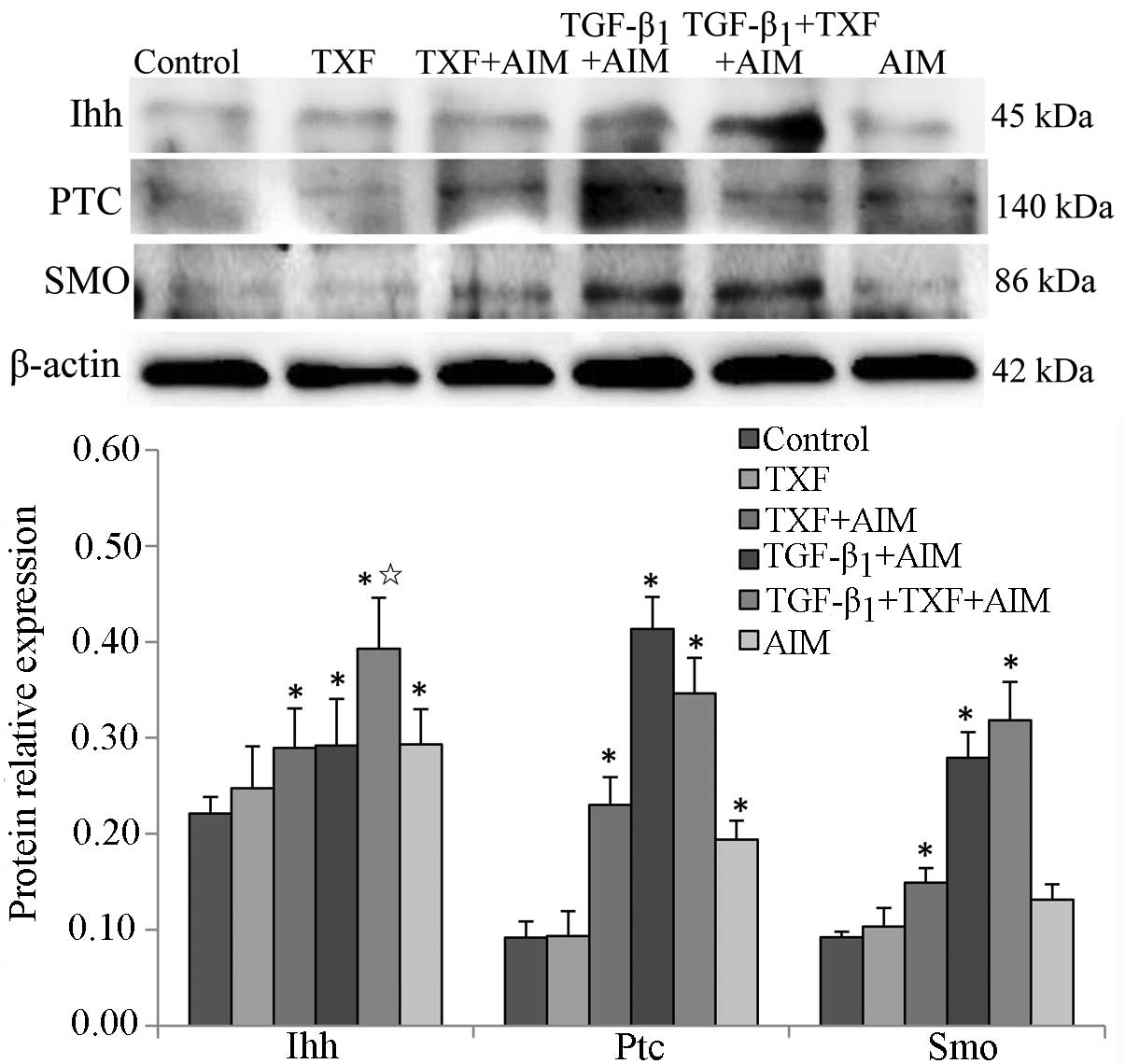|
1
|
Pittenger MF, Mackay AM, Beck SC, et al:
Multilineage potential of adult human mesenchymal stem cells.
Science. 284:143–147. 1999. View Article : Google Scholar : PubMed/NCBI
|
|
2
|
Charbord P: Bone marrow mesenchymal stem
cells: historical overview and concepts. Hum Gene Ther.
21:1045–1056. 2010. View Article : Google Scholar : PubMed/NCBI
|
|
3
|
Pittenger MF and Martin BJ: Mesenchymal
stem cells and their potential as cardiac therapeutics. Circ Res.
95:9–20. 2004. View Article : Google Scholar : PubMed/NCBI
|
|
4
|
Dominici M, Le Blanc K, Mueller I, et al:
Minimal criteria for defining multipotent mesenchymal stromal cells
The International Society for Cellular Therapy position statement.
Cytotherapy. 8:315–317. 2006. View Article : Google Scholar
|
|
5
|
Li WJ, Tuli R, Okafor C, et al: A
three-dimensional nanofibrous scaffold for cartilage tissue
engineering using human mesenchymal stem cells. Biomaterials.
26:599–609. 2005. View Article : Google Scholar
|
|
6
|
Ochi M, Uchio Y, Tobita M and Kuriwaka M:
Current concepts in tissue engineering technique for repair of
cartilage defect. Artif Organs. 25:172–179. 2001. View Article : Google Scholar : PubMed/NCBI
|
|
7
|
Li X, Wei G, Wang X, et al: Targeting of
the Sonic Hedgehog pathway by atractylenolides promotes
chondrogenic differentiation of mesenchymal stem cells. Biol Pharm
Bull. 35:1328–1335. 2012. View Article : Google Scholar : PubMed/NCBI
|
|
8
|
Lin J, Xiu Z and Wu Z: Effect of pilose
antler polypeptides on the apoptosis of rabbit marrow mesenchymal
stem cells differentiated into chondrogenic phenotype in vitro.
Zhongguo Xiu Fu Chong Jian Wai Ke Za Zhi. 20:427–430. 2006.(In
Chinese). PubMed/NCBI
|
|
9
|
Huh JE, Park YC, Seo BK, et al: Cartilage
protective and chondrogenic capacity of WIN-34B, a new herbal
agent, in the collagenase-induced osteoarthritis rabbit model and
in progenitor cells from subchondral none. Evid Based Complement
Alternat Med. 2013:5275612013. View Article : Google Scholar
|
|
10
|
Mak KK, Kronenberg HM, Chuang PT, Mackem S
and Yang Y: Indian hedgehog signals independently of PTHrP to
promote chondrocyte hypertrophy. Development. 135:1947–1956. 2008.
View Article : Google Scholar : PubMed/NCBI
|
|
11
|
St-Jacques B, Hammerschmidt M and McMahon
AP: Indian hedgehog signaling regulates proliferation and
differentiation of chondrocytes and is essential for bone
formation. Genes Dev. 13:2072–2086. 1999. View Article : Google Scholar : PubMed/NCBI
|
|
12
|
Wu Q, Zhang Y and Chen Q: Indian hedgehog
is an essential component of mechanotransduction complex to
stimulate chondrocyte proliferation. J Biol Chem. 276:35290–35296.
2001. View Article : Google Scholar : PubMed/NCBI
|
|
13
|
Hooper JE and Scott MP: The Drosophila
patched gene encodes a putative membrane protein required for
segmental patterning. Cell. 59:751–765. 1989. View Article : Google Scholar : PubMed/NCBI
|
|
14
|
Nakano Y, Guerrero I, Hidalgo A, Taylor A,
Whittle JR and Ingham PW: A protein with several possible
membranespanning domains encoded by the Drosophila segment polarity
gene patched. Nature. 341:508–513. 1989. View Article : Google Scholar : PubMed/NCBI
|
|
15
|
Taipale J, Cooper MK, Maiti T and Beachy
PA: Patched acts catalytically to suppress the activity of
Smoothened. Nature. 418:892–897. 2002. View Article : Google Scholar : PubMed/NCBI
|
|
16
|
Li X, Lang W, Ye H, et al: Tougu Xiaotong
capsule inhibits the tidemark replication and cartilage degradation
of papain-induced osteoarthritis by the regulation of chondrocyte
autophagy. Int J Mol Med. 31:1349–1356. 2013.PubMed/NCBI
|
|
17
|
Li XH, Wu MX, Ye HZ, et al: Experimental
study on the suppression of sodium nitroprussiate-induced
chondrocyte apoptosis by Tougu Xiaotong Capsule-containing serum.
Chin J Integr Med. 17:436–443. 2011. View Article : Google Scholar : PubMed/NCBI
|
|
18
|
Zhang M, Xie R, Hou W, et al: PTHrP
prevents chondrocyte premature hypertrophy by inducing
cyclin-D1-dependent Runx2 and Runx3 phosphorylation, ubiquitylation
and proteasomal degradation. J Cell Sci. 122:1382–1389. 2009.
View Article : Google Scholar : PubMed/NCBI
|
|
19
|
Hwang SG, Song SM, Kim JR, Park CS, Song
WK and Chun JS: Regulation of type II collagen expression by
cyclin-dependent kinase 6, cyclin D1, and p21 in articular
chondrocytes. IUBMB Life. 59:90–98. 2007. View Article : Google Scholar : PubMed/NCBI
|
|
20
|
Neuhuber B, Swanger SA, Howard L, Howard
L, Mackay A and Fischer I: Effects of plating density and culture
time on bone marrow stromal cell characteristics. Exp Hematol.
36:1176–1185. 2008. View Article : Google Scholar : PubMed/NCBI
|
|
21
|
Chen ZZ, Van Bockstaele DR, Buyssens N, et
al: Stromal populations and fibrosis in human long-term bone marrow
cultures. Leukemia. 5:772–781. 1991.PubMed/NCBI
|
|
22
|
Nurse P: Ordering S phase and M phase in
the cell cycle. Cell. 79:547–550. 1994. View Article : Google Scholar : PubMed/NCBI
|
|
23
|
Shen R, Wang X, Drissi H, Liu F, O’Keefe
RJ and Chen D: Cyclin D1-cdk4 induce runx2 ubiquitination and
degradation. J Biol Chem. 281:16347–16353. 2006. View Article : Google Scholar : PubMed/NCBI
|
|
24
|
Pufe T, Petersen W, Fändrich F, et al:
Programmable cells of monocytic origin (PCMO): a source of
peripheral blood stem cells that generate collagen type
II-producing chondrocytes. J Orthop Res. 26:304–313. 2008.
View Article : Google Scholar
|
|
25
|
Oldberg A, Antonsson P, Lindblom K and
Heinegård D: COMP (cartilage oligomeric matrix protein) is
structurally related to the thrombospondins. J Biol Chem.
267:22346–22350. 1992.PubMed/NCBI
|
|
26
|
Horie M, Choi H, Lee RH, et al:
Intra-articular injection of human mesenchymal stem cells (MSCs)
promote rat meniscal regeneration by being activated to express
Indian hedgehog that enhances expression of type II collagen.
Osteoarthritis Cartilage. 20:1197–1207. 2012. View Article : Google Scholar : PubMed/NCBI
|
|
27
|
Hettrich CM, Crawford D and Rodeo SA:
Cartilage repair: third-generation cell-based technologies - basic
science, surgical techniques, clinical outcomes. Sports Med
Arthrosc. 16:230–235. 2008. View Article : Google Scholar : PubMed/NCBI
|
|
28
|
Beier F: Cell-cycle control and the
cartilage growth plate. J Cell Physiol. 202:1–8. 2005. View Article : Google Scholar
|
|
29
|
Ito H, Rucker E, Steplewski A, et al:
Guilty by association: some collagen II mutants alter the formation
of ECM as a result of atypical interaction with fibronectin. J Mol
Biol. 352:382–395. 2005. View Article : Google Scholar : PubMed/NCBI
|
|
30
|
Agarwal P, Schulz JN, Blumbach K, et al:
Enhanced deposition of cartilage oligomeric matrix protein is a
common feature in fibrotic skin pathologies. Matrix Biol.
32:325–331. 2013. View Article : Google Scholar : PubMed/NCBI
|
|
31
|
Miura Y, Parvizi J, Fitzsimmons JS and
O’Driscoll SW: Brief exposure to high-dose transforming growth
factor-beta1 enhances periosteal chondrogenesis in vitro: a
preliminary report. J Bone Joint Surg Am. 84-A:793–799.
2002.PubMed/NCBI
|
|
32
|
McMahon AP, Ingham PW and Tabin CJ:
Developmental roles and clinical significance of hedgehog
signaling. Curr Top Dev Biol. 53:1–114. 2003. View Article : Google Scholar : PubMed/NCBI
|
|
33
|
Choi SW, Jeong DU, Kim JA, et al: Indian
Hedgehog signalling triggers Nkx3.2 protein degradation during
chondrocyte maturation. Biochem J. 443:789–798. 2012. View Article : Google Scholar : PubMed/NCBI
|
|
34
|
Enomoto-Iwamoto M, Nakamura T, Aikawa T,
et al: Hedgehog proteins stimulate chondrogenic cell
differentiation and cartilage formation. J Bone Miner Res.
15:1659–1668. 2000. View Article : Google Scholar : PubMed/NCBI
|
|
35
|
Bruce SJ, Butterfield NC, Metzis V, Town
L, McGlinn E and Wicking C: Inactivation of Patched1 in the mouse
limb has novel inhibitory effects on the chondrogenic program. J
Biol Chem. 285:27967–27981. 2010. View Article : Google Scholar : PubMed/NCBI
|

















